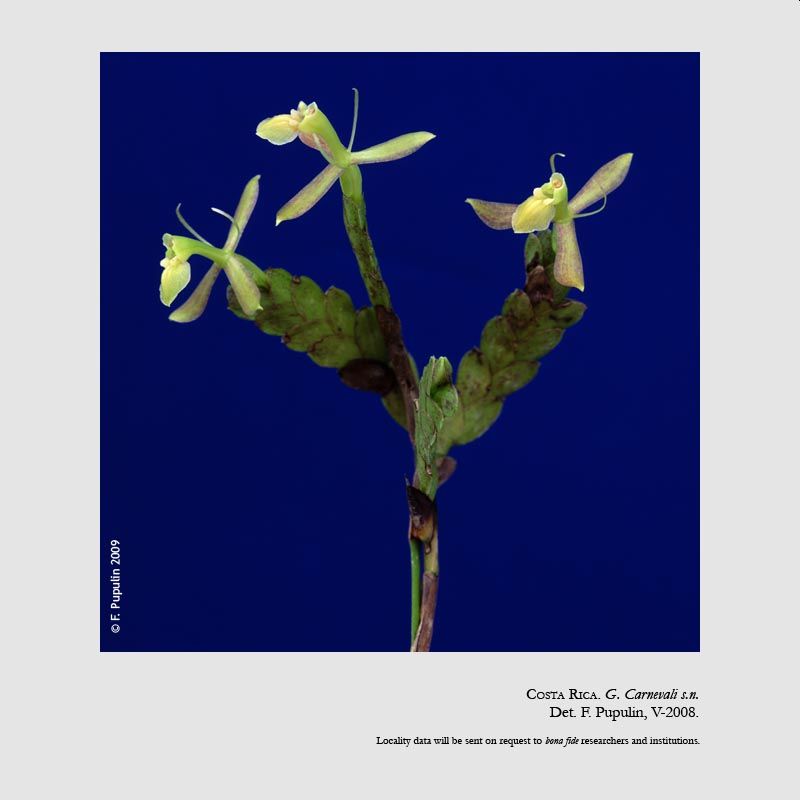

Epidendrum adnatum Ames & C.Schweinf. 1925 GROUP Alberti SUBGROUP Allenii
Photo by © Carnevali, Used under permission of Epidendra Website CR
Specimen courtesy of Epidendra Webpage
Drawing by © Jimenez, Hágsater & E.Santiago and The AMO Herbario Website







Common Name The Adnate Epidendrum [refers to the lip that is united to the column]
Flower Size .8" [2 cm]
Found in Costa Rica, Panama and Ecuador at elevations of 550 to 1700 meters as a miniature to medium sized, warm to cool growing epiphyte with a simple, cane-like, terete at the base, laterally compressed above, somewhat ancipitose, erect, straight stem carrying 4 to 7, all along the stem, articulate, alternate, suberect, linear-lanceolate, long-acuminate apically, cuneate below into the base leaves that blooms at most any time of the year on an apical, rarely lateral, racemose, apically elongate, laterally sessile, laterally compressed, ancipitose, two winged, 6 to 20 flowered inflorescence arising through a triangular-lanceolate, subacute, tubular at the base becoming conduplicate towards the apex, spathaceous bract.
"Epidendrum adnatum belongs to the GROUP Alberti which is characterized by the sympodial habit laterally compressed to ancipitose or somewhat fusiform-thickened stems, the apical or apical and lateral racemose, distichous inflorescence more or less with imbricating bracts on the peduncle, producing one flower at a time, and the SUBGROUP Allenii which is characterized by the stems with numerous leaves, the apical inflorescence (rarely lateral), peduncle elongate, bare, non-bract bearing, two-winged, the rachis short, covered by rounded, usually imbricating bracts. The species is recognized by the delicate plants with thin stems and narrow, linear-lanceolate to linear-elliptic, acuminate leaves 1.8 to 9" x .24 to .72" [4.5 to 22.5 x .6 to 1.8 cm], oblanceolate subacute sepals .36 to .48" [9 to 12 mm] long, linear-filiform petals, and the lip ovate and subacute with the base truncate, .16 to .36" x .14 to .168" [4 to 5.4 x 3.5 to 4.2 mm]. Epidendrum lankesteri Ames has larger plants with wider leaves, narrow elliptic to lanceolate leaves 2.2 to 10.8" x .6 to 1.2" [5.5 to 27 x 1.5 to 3 cm], sepals .52 to .64" [13 to 16 mm] long, a subcordiform lp obscurely 4-lobed at the basal half, subacute, with the base deeply cordate, .24 to .36" x .16 to .3" [6 to 9 x 4 to 7.5 mm]. Epidendrum panamense Schltr. is vegetatively similar, but the plants are shorter to 8.4" [21 cm] tall the leaves somewhat shorter 2 to 5.8" [5 to 14.5 cm] long, and the lip widely ovate-cordiform, with the base cordate and the apex rounded and .14 to .2" x .14 to .228" [3.5 to 5 x 3.5 to 5.7 mm]. Epidendrum jefeallenii Hágsater & Carda-Cruz has plants of about the same size and shape, but the sepals are narrowly obovate, obtuse, .34 to .4" [8.5 to 10 mm] long, and the lip cordiform, .16 to .2" x .2 to .24" [4 to 5 x 5 to 6 mm], with the base cordate and with a pair of rounded, short sinii near the apex." Hagsater etal 2007
Synonyms
References W3 Tropicos, Kew Monocot list , IPNI ; The Genus Epidendrum Ames 1936; Ceiba Vol 5 No 1 L O Williams 1956; Icones Orchidacearum 3 Plate 339 Hagsater & Sanchez 1999 see recognition section; Icones Orchidacearum 3 Plate 352 Hagsater & Sanchez 1999 see recognition section; Manual de las Plantas de Costa Rica Vol 3 Hammel, Grayum, Herrera and Zamora 2003; Vanishing Beauty, Native Costa Rican Orchids Vol 1 Pupulin 2005 photo fide; Icones Orchidacearum 9 Plate 901 Hagsater 2007 drawing fide; Icones Orchidacearum 9 Plate 952 Hagsater 2007 see recognition section; Orchids of Costa Rica Vol 3 Morales 2009 photo fide; Icones Orchidacearum 14 Plate 1453 Hagsater & Sanchez 2013 see recognition section; Icones Orchidacearum 16[1]Plate 1665 Hagsater & Sanchez 2018 see recognition section;
--------------------------------------------------------------------------------------------------------------------------